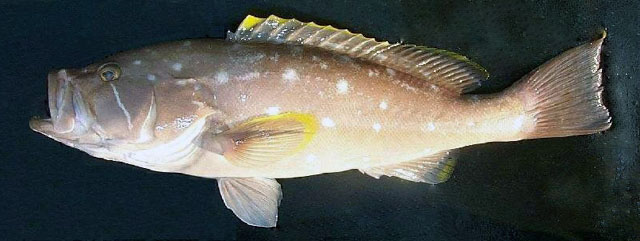| Epinephelidae (Groupers) |
| 115 cm TL (male/unsexed); max.weight: 19 kg; max. reported age: 35 years |
|
demersal; marine; depth range 90 - 360 m |
| Western Atlantic: North Carolina, USA to southern Brazil, including Gulf of Mexico and the Caribbean. |
|
Dorsal spines (total): 11-11; Dorsal soft rays (total): 13-15; Anal spines: 3-3; Anal soft rays: 9-9. Distinguished by the following characteristics: buff or greyish brown head and body, whitish ventrally; yellow margins of dorsal and pectoral fins, sometimes including anal and caudal fins; pale blue line from the eye to the angle of preopercle; depth of body less than head length, contained 2.7-2.9 times in SL; head length 2.4-2.6 times in SL; convex interorbital area; angular preopercle, serrae at the angle distinctly enlarged; eye diameter equal to or greater than interorbital width in fish less than 45 cm SL; posterior and anterior nostrils subequal in size (Ref. 89707). |
| A solitary species (Ref. 26340) occurring in rocky areas and on sand mud bottom. On soft bottoms they are often seen in or near trenches or burrow-like excavations. Feeds on a wide variety of invertebrates (mainly brachyuran crabs) and fishes. Marketed fresh and considered good quality. |
|
Vulnerable (VU); Date assessed: 21 November 2016 (A2bd+4bd) Ref. (130435)
|
| harmless |
Source and more info: www.fishbase.org. For personal, classroom, and other internal use only. Not for publication.

